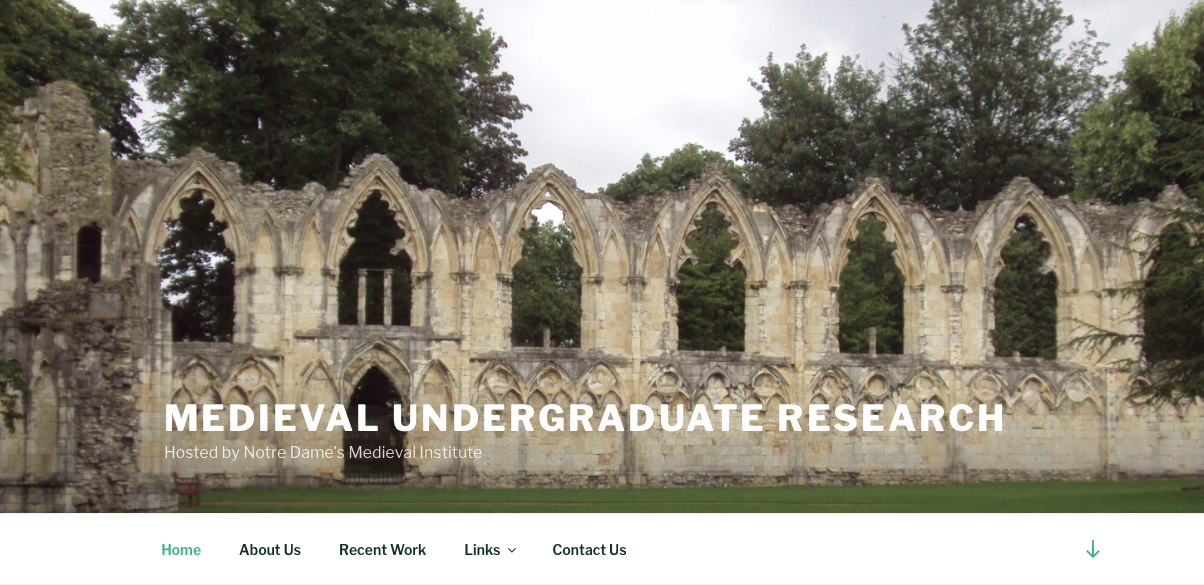Part 1 of this blog entry presented the rationale behind using the Medieval Studies Research Blog (MSRB) as a pedagogical tool. Part 2 dives into the practical side of graduate-level blog post assignments specifically tailored to the MSRB’s interdisciplinary mission.
Precedent has already been set for bringing the MSRB into the graduate classroom. In fact, the MSRB originally emerged out of Kathryn Kerby-Fulton’s manuscript studies course, and her students continue to contribute exceptional work. During the fall 2017 semester, for instance, Kerby-Fulton’s class, “Introduction to Medieval English Manuscript Studies,” worked on the following assignment, for which I recently gave a guest lecture on “How to Write a Successful Blog Post:”
Workshop Assignment: The Workshop Assignment will be the creation of a blog post of about 500 words. Dr. Karrie Fuller (Medieval Institute’s Medieval Studies Research Blog webmaster and Lecturer, St. Mary’s College) will explain the format for this, and both she and I will be happy to help as well to advise on content. It should be delivered on the workshop day; note that your oral presentation of your post should not exceed 5 - 10 minutes, not counting questions afterwards). This assignment is an excellent preparation for conference roundtables and panels.
When constructing a blog assignment for this site, the only restrictions are that the subject matter should somehow relate to the medieval period, and contributions should be written in a style appropriate to the academic blog. Otherwise, the possibilities remain wide open. As in the example just provided, many traditional forms of academic writing and oral presentation can be adapted to fit the blog format, whether as one component of a larger project, or on its own. There is also plenty of room for experimentation with multimedia, tone, creative responses to or reflection on course content. Furthermore, because the site’s interdisciplinary coverage reflects the full range of scholarly activity performed at Notre Dame, instructors from all disciplines should feel welcome to participate.
For additional support with these assignments, the Medieval Institute has recently approved a new classroom visit program. These visits are by no means required for instructors assigning blog posts for this site, but are available for anyone wanting a little extra help preparing students for the task. Visits consist of a twenty-minute guest lecture about how to put together a successful blog post and set it up on WordPress. The graduate students in attendance for my first class visit earlier this semester responded positively to the experience, and will know exactly what to expect when it comes time to prepare their work for publication. Anyone interested in scheduling a class visit can contact me directly (email address listed below).
Moreover, helping graduate students at an early stage of their training to see the benefits of contributing posts will, ideally, encourage them to continue submitting their work as they advance beyond coursework. Becoming a regular, or even an occasional contributor will be even more effective than publishing a single entry as it will demonstrate a more sustained involvement with a large-scale digital project. Because curating an online presence is now a necessity for scholars, this form of professionalization can help graduate students manage their online profiles, making them more memorable, as Battershill suggests, “It is a good idea, in other words, for each grad student to take the time to craft an online presence that is what they want it to be—that is, intentional, professional, and memorable. Students should know what comes up when search committees or journal editors Google their names, and ideally they should try to make sure that the search results on the first few pages include some indication of their academic work.”[1] This site’s university affiliation means that it will show up first in Google searches, and its short article format means that it will add new content to the CVs and publication lists already present on their academia.edu and LinkedIn pages. Contributions are also circulated via Twitter and Facebook to expand their online visibility.
Ultimately, using this site as the basis for course assignments benefits everybody involved. Students and instructors gain DH experience, the Medieval Institute continues to build a strong online research profile, and audiences outside the academy gain greater access to knowledge they would otherwise never receive.
For questions, posting schedules, or class visit sign-ups, feel free to contact me at kfuller2@alumni.nd.edu.
Karrie Fuller, Ph.D.
University of Notre Dame/St. Mary’s College
Update 5/4/18: Here is sample assignment that could be adapted easily for graduate students.
Select Bibliography of Introductions to DH and DH Pedagogy
Battershill, Claire and Shawna Ross. Using Digital Humanities in the Classroom: A Practical Introduction for Teachers, Lecturers, and Students. London: Bloomsbury Publishing, 2017.
Burdick, Anne, Johanna Drucker, Peter Lunenfeld, Todd Presner, and Jeffrey Schnapp. Digital_Humanities. Cambridge, MA: MIT Press, 2012.
Gardner, Eileen and Ronald G. Musto. The Digital Humanities: A Primer for Students and Scholars. Cambridge: Cambridge University Press, 2015.
Gold, Matt K., and Lauren Klein, eds. Debates in Digital Humanities 2016. Minneapolis: University of Minnesota Press, 2016.
Hirsch, Brett D., ed. Digital Humanities Pedagogy: Practices, Principles and Politics. Cambridge: Open Book Publishers, 2012.
Schreibman, Susan, Ray Siemans, and John Unsworth, eds. A New Companion to Digital Humanities. Blackwell Companions to Literature and Culture. Chicester: Wiley Blackwell, 2016.
[1] Claire Battershill and Shawna Ross, Using Digital Humanities in the Classroom: A Practical Introduction for Teachers, Lecturers, and Students (London: Bloomsbury Publishing, 2017): 158-159.



